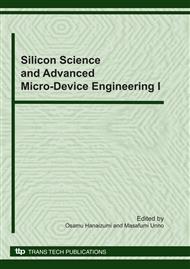p.63
p.67
p.71
p.78
p.84
p.92
p.100
p.111
p.116
Relationship between Dielectric Characteristic by DEP Levitation and Differentiation Activity for Stem Cells
Abstract:
In our previous study, we discussed the possibility of differentiation activity measurement for rat mesenchymal stem cells (RMSC) by Dielectrophoretic (DEP) levitation. Consequently, it was found that the differentiation activity of the RMSC could be evaluated by DEP levitation without the differentiation induction. Thus, we discuss the possibility of differentiation activity evaluation by DEP levitation with cells other than the RMSC. Human mesenchymal stem cells (HMSC) and human adipose tissue-derived stem cells (ASC) were used as the sample cells. The dielectric characteristics (Re[K(ω)]) measurement, the Re[K(ω)] of both the HMSC and the ASC decreased with the increasing passage number. Moreover, to evaluate the differentiation activity of the HMSC and the ASC that had performed the osteoblast differentiation induction, the amount of Alkaline Phosphatase (ALP) was measured. Consequently, the ALP activity of both the HMSC and ASC decreased with increasing the passage number. Therefore, it was found that the differentiation activity of the HMSC and the ASC could be evaluated by measuring the Re[K(ω)] due to the relationship between the Re[K(ω)] and ALP activity.
Info:
Periodical:
Pages:
84-91
Citation:
Online since:
December 2010
Authors:
Keywords:
Price:
Сopyright:
© 2011 Trans Tech Publications Ltd. All Rights Reserved
Share:
Citation:


